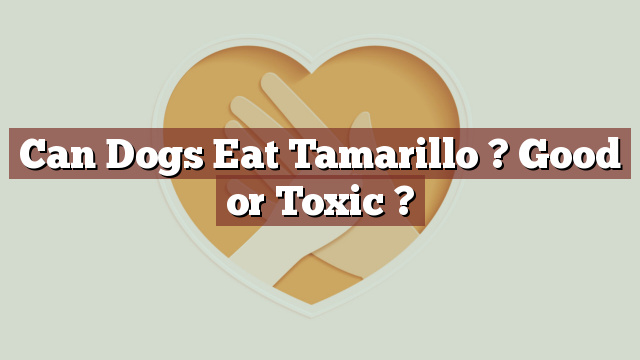Can Dogs Eat Tamarillo? Good or Toxic?
Feeding our furry friends a balanced and safe diet is a top priority for any responsible pet owner. As such, it is crucial to be aware of the foods that dogs can and cannot consume. One particular fruit that may raise questions is the tamarillo. In this article, we will explore whether dogs can eat tamarillo, and if so, the potential risks and benefits associated with its consumption.
Nutritional Value of Tamarillo: Essential Vitamins and Minerals
Tamarillo, also known as the tree tomato, is a tropical fruit native to South America. It is known for its vibrant red or purple skin and unique taste. In terms of nutritional value, tamarillo is a rich source of essential vitamins and minerals. It contains vitamins A, C, and E, which play a vital role in supporting a dog’s immune system, promoting healthy skin, and maintaining good vision. Additionally, tamarillo is packed with antioxidants and dietary fiber, which can contribute to overall well-being.
Can Dogs Eat Tamarillo? Understanding Safety and Toxicity
Can dogs eat tamarillo? The answer is no. While tamarillo can offer some nutritional benefits, it is important to note that this fruit can be toxic to dogs. Tamarillo belongs to the Solanaceae family, which includes other potentially harmful foods for canines, such as tomatoes and potatoes. These fruits contain solanine, a natural toxin that can cause digestive upset and even neurological symptoms in dogs. Therefore, it is best to avoid feeding tamarillo to our four-legged companions to ensure their safety and well-being.
Potential Risks and Benefits of Tamarillo Consumption for Dogs
Although tamarillo may have health benefits for humans, such as improving digestion and boosting the immune system, the same cannot be said for dogs. The risks associated with tamarillo consumption by dogs outweigh any potential benefits. Ingesting this fruit can lead to stomach discomfort, vomiting, diarrhea, and in severe cases, it may even result in more serious health complications. It is always better to err on the side of caution and prioritize our dog’s safety over any potential advantages.
My Dog Ate Tamarillo, What Should I Do? Immediate Steps to Take
If your dog has accidentally consumed tamarillo, it is important to take immediate action. The first step is to remove any remaining fruit or seeds from their reach to prevent further ingestion. Next, observe your dog for any signs of discomfort or adverse reactions. If your dog exhibits symptoms such as vomiting, diarrhea, or appears lethargic, it is crucial to contact your veterinarian promptly. They will be able to provide professional guidance tailored to your specific situation and advise on any necessary treatments or monitoring.
In Conclusion: Tamarillo as an Occasional Treat for Dogs
In conclusion, tamarillo is not considered safe for dogs to consume. While it contains beneficial nutrients for humans, the potential risks associated with its consumption in dogs outweigh any potential benefits. It is essential to prioritize the well-being of our four-legged companions by providing them with a balanced and appropriate diet. If you are ever unsure about the safety of a particular food for your dog, consulting with a veterinarian is always the best course of action. Remember, a responsible pet owner is a well-informed one.
Thank you for investing your time in exploring [page_title] on Can-Eat.org. Our goal is to provide readers like you with thorough and reliable information about various dietary topics. Each article, including [page_title], stems from diligent research and a passion for understanding the nuances of our food choices. We believe that knowledge is a vital step towards making informed and healthy decisions. However, while "[page_title]" sheds light on its specific topic, it's crucial to remember that everyone's body reacts differently to foods and dietary changes. What might be beneficial for one person could have different effects on another. Before you consider integrating suggestions or insights from "[page_title]" into your diet, it's always wise to consult with a nutritionist or healthcare professional. Their specialized knowledge ensures that you're making choices best suited to your individual health needs. As you navigate [page_title], be mindful of potential allergies, intolerances, or unique dietary requirements you may have. No singular article can capture the vast diversity of human health, and individualized guidance is invaluable. The content provided in [page_title] serves as a general guide. It is not, by any means, a substitute for personalized medical or nutritional advice. Your health should always be the top priority, and professional guidance is the best path forward. In your journey towards a balanced and nutritious lifestyle, we hope that [page_title] serves as a helpful stepping stone. Remember, informed decisions lead to healthier outcomes. Thank you for trusting Can-Eat.org. Continue exploring, learning, and prioritizing your health. Cheers to a well-informed and healthier future!

